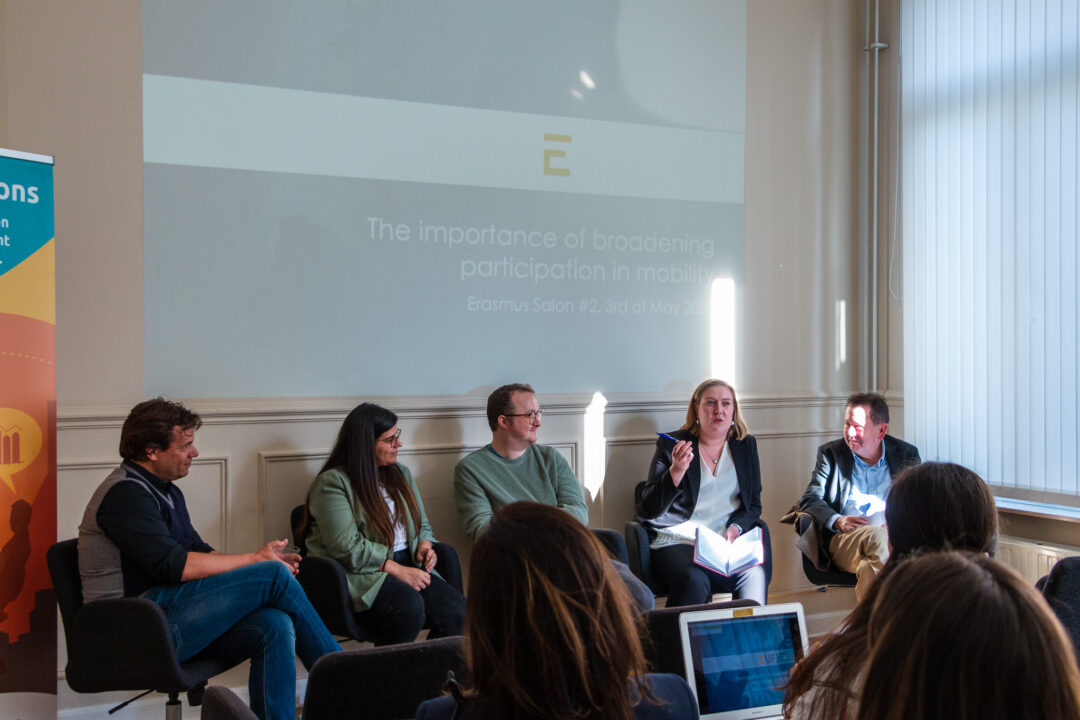On May 3rd, the second Erasmus Salon brought together different stakeholders to reflect on the question of “Erasmus for All”. The focus was on socioeconomic obstacles to participation that keep Erasmus+ from being more inclusive and fair, limitations of the current grant calculation scenarios, and how mobility could be made more accessible across the European Education Area.
The Salon opened with an intervention by Joao Bacelar, Executive Manager of the European University Foundation (EUF), in which he specified the focus areas that the EUF is working on within the broader challenge of improving inclusion and participation in mobility. These include accurately mapping average student accommodation costs per city, employing scalable and comparable methodologies to assess the gap between mobile and the overall student population, the needs of working and displaced students, as well as the improvement of mobility student support systems.
Following this introduction, there were interventions from a range of excellent speakers, including Carle Bonafous-Murat (Senior Liaison Officer, Brussels bureau of France Universités, President of the French Euraxess network) who argued that it is important to work together to tackle the problem of grants not being able to cover the living costs of students from a European point of view, and that we must have a practice-based approach for this.
Wim Gabriels, Director of ESN, raised the issue that grants cover only a fraction of mobility expenses, and that such difficulties are further compounded by delays in their payment. At present, only 30% of students get their grant before departure despite facing significant extra costs to cover at the beginning of the mobility. Furthermore, intersectionality is another dimension to be considered, about 77% of students from minority backgrounds said they would need between 75% to 100% of their costs covered to be able to participate.
Caroline Sundberg (Brussels Representative of Southern Swedish Universities) added that we must invest more in mobility if we are truly committed to creating a European market for knowledge. However, this is made difficult because neither the European Commission nor Member States invest enough in this, while some students do not perceive the advantages or need for this. She also presented the view of Swedish University students, who, overall, have lower intentions to go abroad, for instance due to lack of promotion of mobility windows, the relatively secure financial situation, and the perception that teaching methods abroad are more stressful and difficult. Some measures to overcome this include putting more effort into dispelling such myths and working for internationalisation at home by encouraging Swedish students to familiarise themselves with other students.
Finally, Helena Alves (Policy and Research Officer at the EUF) presented the grant calculation scenarios currently under development by the Erasmus 4 All project. These scenarios include:
- 1st scenario: Updating the current country grouping in the Erasmus+ grant system by splitting counties into 4 groups and using reliable and publicly available information such as the Eurostat housing price index to classify them.
- 2nd scenario: Combining an equal baseline grant across Europe with a supplement aiming to cover the difference between cost of living in the home city or regions and the host one; students would also receive a return travel ticket for each semester abroad.
- 3rd scenario: A monthly baseline amount defined at the sending HEI and comparing the cost of living of the origin and destination cities. This baseline will then be multiplied by the increase or decrease in costs.
A discussion afterwards allowed for a lively and fruitful exchange with the audience, who concluded that since inclusion is a priority for the whole Erasmus + programme, we need to put more effort in making it accessible to all students, which will require a more ambitious approach to how the Erasmus+ grants currently work.

